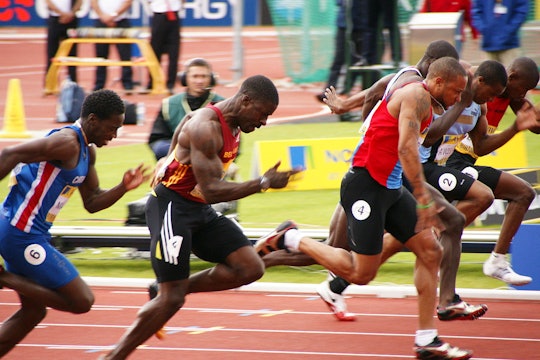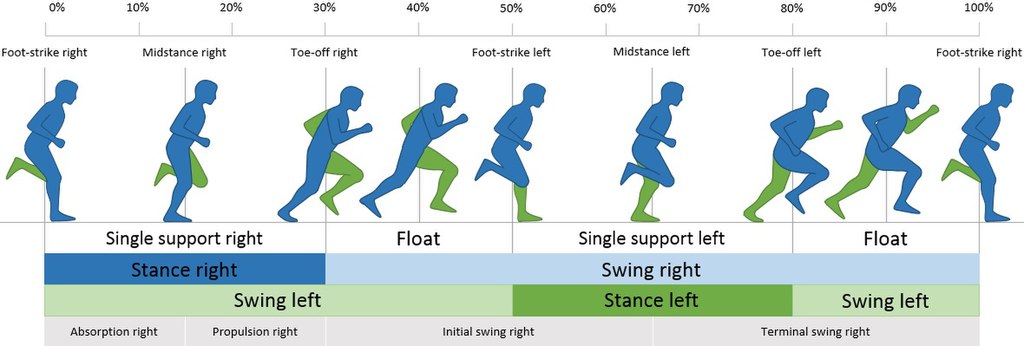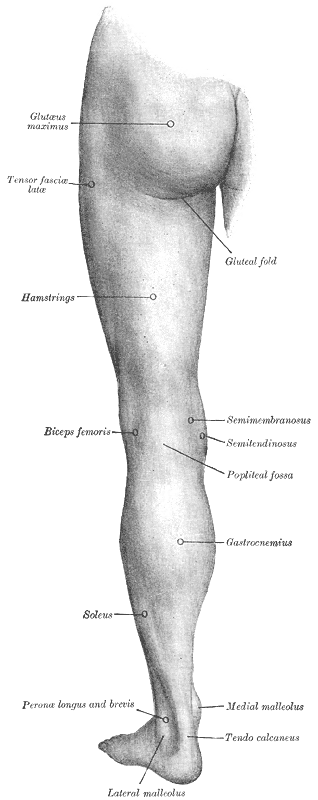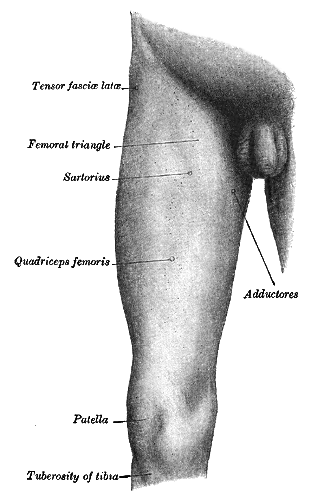
Via Wikimedia
Strong butt muscles are the key to sprinting at an elite level
Instead of the hamstrings, your butt is the real motor behind lightning-fast sprint speeds, at least if you're an elite male sprinter
Ed: Welcome to Butt Month. In the month of September, Massive will be publishing articles on the evolution, science, and technology surrounding the butt. If it touches the butt, we’ll be covering it. Why Butt Month? Why not. For previous butt stories, see the Butt Month page.
By multiple measures, track events are some of the most popular of the Summer Olympics. Without complicated rules or penalties or fourth downs that somehow magically revert back to third downs, it’s the simplest of sports: who crosses the finish line first? The men’s 100-meter sprint is the only race that crowns the “fastest man on earth.” Watching fierce competitions between men and women with bulging muscles at peak athleticism is inspiring. But which of those muscles actually matter the most when it comes to a sprinter winning gold? It is commonly believed that the hamstrings are the most important muscle to develop for speed, but new research points to your butt as the real way to leave everyone else behind.
The mechanics and muscles of sprinting have been open research questions for decades, with the general consensus pointing towards the hamstring muscles as the primary power source for elite sprinters. Bigger, stronger hamstrings have been related to faster sprint times, and the hamstring muscle in particular has been shown to strongly activate when running. Moreover, mathematical simulations of a person sprinting seem to show that the hamstrings are especially important for generating forward motion. Some scientists even argue that the prevalence of hamstring injuries in sprinters means that they must be the primary muscle group involved.
The running gait is generally divided into two phases: the stance phase, when the foot is in contact with the ground, and the swing phase, when the foot is fully off the ground and swinging forward through the air. Each part of the gait involves extra effort from different muscles. When the foot reaches forward at the end of the swing phase and then contacts the ground during the first part of the stance phase, the muscles are working primarily to decelerate the body and then prepare for the next push-off. The butt muscles are most active during this part of the gait, along with the calf muscles. The quadriceps, at the front of the thigh, come in primarily during the middle of the stance phase, generating push-off power while the abdominal muscles and the muscles along the sides of the leg provide stabilization. The hamstrings have a few different jobs — while they are active during the foot strike and the first part of the stance phase, they are actually more important for the swing phase, pulling the leg forward quickly through the air to prepare to strike the ground again. Since the hamstring is working hard and is also the most stretched out right at the end of the swing phase, this is when hamstring injuries tend to happen.

A diagram showing the steps involved in a running gait
Via Wikimedia
It’s true that bigger hamstrings generally correlate to faster sprint times. However, most research that examined hamstring muscles mostly compared them to the quadriceps and calf muscles and did not include the butt muscles as part of the study. To remedy that, researchers from Loughborough University in the UK recently shifted focus to the butt. They liked what they saw.
The study focuses on the differences in muscle volume and strength between elite sprinters, sub-elite sprinters, and non-sprinters, although only male participants were studied. Using magnetic resonance imaging (MRI), the researchers measured the volume of 23 individual lower limb muscles. The goal was to relate muscle size to personal best sprint times for a 100-meter race, and to see which muscles could be most significantly affecting sprint speed for these male runners.
Overall, while the differences in cross-sectional muscle area between the control group and the sub-elite group was consistent across almost all of the muscles tested, the differences between the elite and the sub-elite group of male sprinters were concentrated in specific areas. Three particular muscles were found to be consistently larger (in both absolute volume and size relative to body weight) in the elite sprinters vs the sub-elite sprinters: the gluteus maximus (largest butt muscle), the tensor fasciae latae right next to the glute, and the sartorius muscle that stretches along the outside of your leg from the hip to the knee. This research implies that once a sprinter is getting close to the elite level, targeted training of the butt and hip flexor could help increase speed. The three muscles that make up the hamstring were also slightly bigger in elite sprinters than in sub-elite sprinters, but those differences were not nearly as pronounced as the much larger butts.

The back of the left thigh of a human, with major muscle groups indicated, including the tensor fasciae latae close to the hip bone
Via Wikimedia
In a second study from Ritsumeikan University in Japan, researchers used MRI technology to compare the size of ten different muscle groups in the legs and lower body between sprinters and non-sprinters, again only using male participants. While it makes sense that all muscles were larger in the sprinters versus the non-sprinters, the gluteus maximus (the largest butt muscle) as well as the psoas major (the muscle that connects the trunk to the lower limbs) showed the biggest difference both in absolute size as well as size relative to body weight. Moreover, a larger gluteus maximus strongly correlated with faster sprint times among the sprinters, while the size of the hamstring muscle did not. One particular strength of this study was the sample size — it included 56 sprinters and 40 non-sprinters, one of the largest studies to date using MRI scans for this type of research.
The authors of the study go as far as to argue that the hamstring “may not be an important muscle for achieving superior sprint performance.” Based on this and the previous research, that’s likely true if you’re already an elite-level sprinter — it may be a good idea to put more focus on glute-specific strengthening exercises. However, if you’re not already competing at the international or even national level and just want to get faster for a weekly pickup soccer game, racing your sibling down the street, or just outrunning your shadow, general leg strength is likely more important than targeted exercises, as seen in the vast difference in overall muscle volume between non-sprinters and sprinters in the study.
There is a striking lack of research on the same topic for female sprinters. While running mechanics are similar between males and females, there are some small differences that emerge most clearly at elite levels, where the fastest male sprinters generally produce faster times than the fastest female sprinters. From a biomechanics perspective, the most efficient running configuration is to have the hips stacked on top of the knees, which are stacked on top of the ankles. Women tend to have wider hips than men, which interferes with this alignment and makes the running gait less efficient. On average, women also have slightly different rotation angles of the knee and hip joints while running, which isn't necessarily slower but does imply that different muscles may be involved compared to a man's running gait.

The front of the right thigh of a human, with major muscle groups indicated, including the sartorius on the inside of the leg towards the groin
Via Wikimedia
Only a single research article was found on muscle volume or strength as it relates to sprint speed for female sprinters. The researchers studied both male and female high school athletes and compared the cross-sectional area of just the psoas major and gluteus maximus muscles between sprinters, distance runners, and untrained students of similar ages. The study reports that the gluteus maximus was larger in male sprinters than in male distance runners, but the same difference was not seen between female sprinters and female distance runners. In addition, faster female sprinters had a significantly larger psoas major compared to slower sprinters but not a larger gluteus maximus, while in male sprinters it was the other way around.
While the subjects of this study are relatively young and not at the elite sprinting level, the results are believable since the mechanics of the sprinting motion itself can be slightly different between males and females due to small structural differences. Further research is needed to see whether this result holds at the elite level.
Overall, when it comes to speed, researchers agree that increasing overall lower body strength is a must. Hamstring strength in particular has historically been the focus, but for those that want an edge over their opponents, the gluteus maximus is the real key. Butts win championships.
